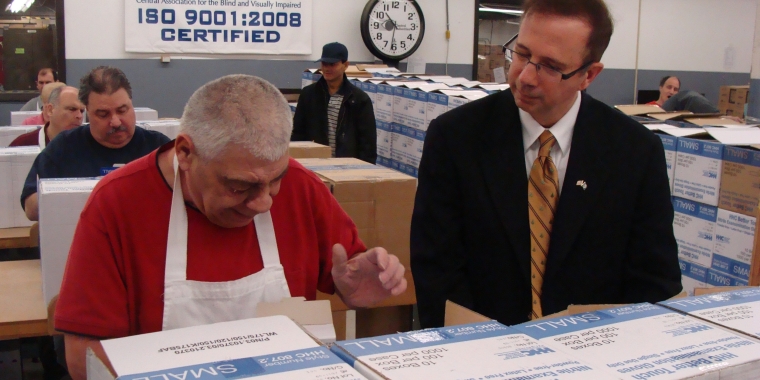
University at Buffalo Study: Blind and Visually Impaired New Yorkers Contribute to New York's Economy
Joseph A. Griffo
December 13, 2011
-
ISSUE:
- Economic Development
- Disability

Major New Analysis Shows Positive Impact of Employment of New Yorkers who are Blind and Visually Impaired
Utica, NY – New York state Senator Joseph Griffo (47th District), and the Central Association for the Blind and Visually Impaired (CABVI), today unveiled a comprehensive study on the economic and quality of life impact of employing workers who are blind throughout New York.
Industries for the Blind New York State (IBNYS) commissioned the study, conducted by the University at Buffalo Regional Institute, entitled, “An Impact Analysis of the Industries for the Blind of New York State & its Affiliated Agencies.”
Senator Griffo said the report presents documentation of opportunities for meaningful employment for people who are blind across New York State. “Ranging from packers and switchboard operators to supervisors and vice presidents, these employees have been able to support their families, live independently and leverage career advancement opportunities.
“Most importantly, they are more confident in their abilities and derive a significant sense of satisfaction from the opportunity to work, grow and be productive members of society,” Sen. Griffo added.
IBNYS employees receive an average hourly wage of $10.16, about 40 percent higher than the NYS minimum wage, and come with basic benefits including health, dental, pension, vacation and sick time. Former New York Governor David Paterson, himself legally blind and an advocate for individuals with disabilities, recently addressed CABVI benefactors saying the agency “provides opportunities to people who are blind, who want to work. The pay is good and the benefits are competitive. This comes amid a national debate about equalizing competitive benefits for the disabled so CABVI is leading the way.”
According to CABVI President and CEO Rudy D’Amico, the study indicates that, if agencies that employ people who are blind, increased their market share with state and local contracts “they could dramatically increase their current employment numbers.
“Our goal is to double the number of blind and visually impaired individuals employed at each of eight IBNYS affiliates by 2016. We will work to secure increased adherence to New York’s preferred-source legislation. Reaching this goal would result in the creation of more than 400 new jobs for blind persons statewide.” CABVI currently employs 100 people who are blind or visually impaired.
New York State Finance Law requires state agencies, political subdivisions and public benefit corporations (which include most public authorities) to purchase commodities or services from a preferred source when the form, function and utility required is comparable, and the price, as determined by OGS, is no more than 15 percent above the prevailing market rate.
Richard Healey, President of IBNYS said. “The missing ingredient is the opportunity. We are dedicated to creating those opportunities from Brooklyn to Buffalo.
“We represent one-percent of state agency spending. Obviously not a significant number but it is more than $11 million,” Healey said. “If we were able to increase our market share to two-percent, we could put more blind people to work, create more-taxpayers, and at the same time reduce the number of people on public assistance.”
Private agencies affiliated with IBNYS directly create jobs for almost 900 workers, 440 of whom are blind. CABVI employs 200, half of whom are legally blind or visually impaired. A significant number of blind employees are women and minority groups, suggesting the impact these agencies have on populations that have traditionally faced employment barriers.
According to the report:
• The total economic impact of the eight agencies on the state’s economy is $168 million, reflecting $88.3 million in direct sales, through more than 21,600 orders, as well as $80 million in spinoff activity in related industries. Put another way, $100 in sales of blind made goods and services supports $90 in additional business and household spending across NYS;
• About 60 percent of total sales come from the federal government and other out of state buyers, representing new dollars funneled into the NYS economy;
• Blind workers who receive vocational and rehabilitation/training achieve employment mobility. Advancement within agencies is common for blind workers, and 7 percent are eventually attracted to jobs outside the agency in the public or private sectors.
“The UB report proves what affiliates and workers across New York have said for years: Workers who are blind or visually impaired are efficient, conscientious, and exceptional employees,” Mr. D’Amico added.
Eight nonprofit organizations across New York State in Albany, Binghamton, Buffalo, Brooklyn, Elmira, New York City, Rochester and Utica partner with IBNYS to provide employment for blind New Yorkers through the production of goods and services.
-30-